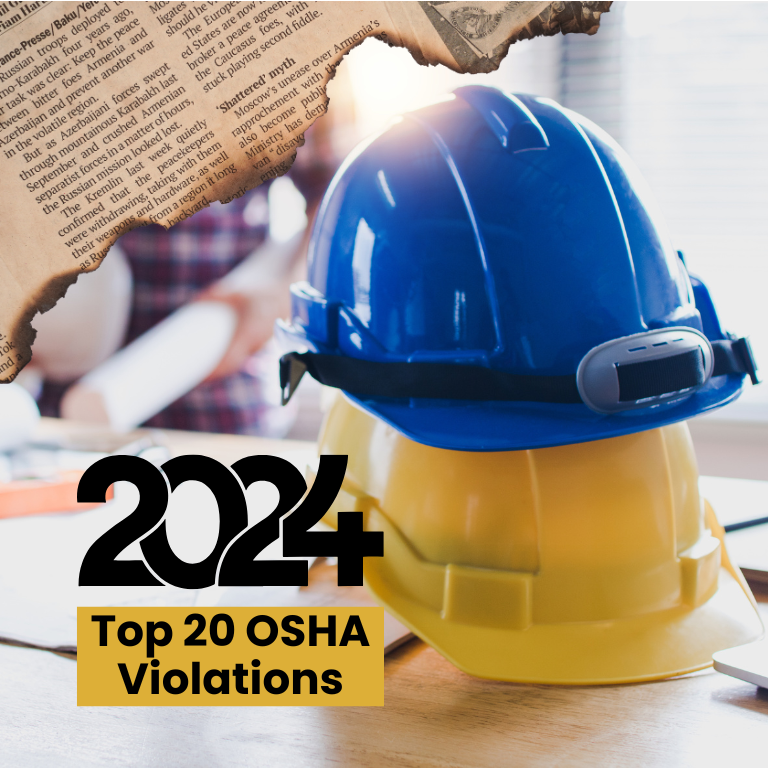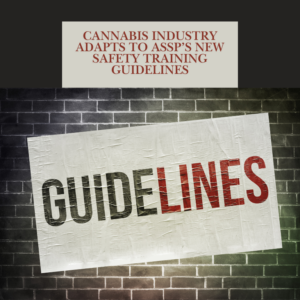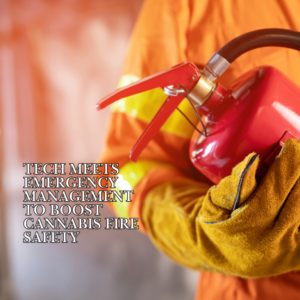Biggest OSHA Violations of 2024: Top 20 Offenses in Workplace Safety


Workplace safety is a critical concern for both employees and employers. The Occupational Safety and Health Administration (OSHA) is responsible for setting and enforcing standards to ensure safe and healthy working conditions in the United States. Each year, OSHA publishes a list of the most frequently cited safety violations to raise awareness and encourage businesses to prioritize compliance.
In 2024, OSHA’s Top 20 violations list highlights ongoing safety risks that continue to endanger workers across various industries. This article provides an in-depth look at the most common violations, how they impact workplace safety, and what companies can do to avoid these pitfalls.
1. Fall Protection (General Requirements) – 1926.501
For several years, fall protection has topped OSHA’s list of violations, and 2024 is no different. Falls are one of the leading causes of fatalities in the workplace, particularly in the construction industry. OSHA’s standard 1926.501 mandates employers to provide proper fall protection systems, such as guardrails, safety nets, and personal fall arrest systems.
Despite the clear guidelines, many companies fail to implement adequate measures, leading to tragic accidents. Common violations include the lack of fall protection on elevated work surfaces and inadequate training for workers on the use of protective equipment.
2. Hazard Communication – 1910.1200
Hazard communication is essential in any workplace that handles hazardous chemicals. Employers are required to inform and train their workers about the dangers of chemicals they may be exposed to. This includes labeling containers correctly, providing safety data sheets (SDSs), and ensuring proper handling procedures.
Violations occur when companies fail to maintain up-to-date chemical inventories, neglect employee training, or provide insufficient labeling, all of which can lead to serious health hazards like chemical burns, respiratory issues, and even long-term illnesses.
3. Respiratory Protection – 1910.134
Proper respiratory protection is crucial for workers exposed to harmful dust, fumes, gases, and other airborne contaminants. OSHA’s respiratory protection standard requires employers to assess workplace air quality, provide appropriate respirators, and train employees on their use.
In 2024, respiratory protection violations remain a significant issue. These violations often stem from inadequate respirator fit testing, failure to maintain a respiratory protection program, or neglecting to provide the correct type of respirator for the hazards present.
4. Ladders – 1926.1053
Ladders are commonly used in many industries, but improper use can lead to severe accidents. OSHA’s ladder standard outlines safe practices for ladder use, including requirements for proper placement, stability, and worker training.
Violations in this category often involve using ladders with structural defects, incorrect positioning, or failing to ensure that ladders extend far enough beyond the landing surface for safe access. These oversights can result in falls, injuries, or even fatalities.
5. Control of Hazardous Energy (Lockout/Tagout) – 1910.147
Lockout/Tagout (LOTO) procedures are essential for preventing accidental startup or release of hazardous energy during maintenance or repair work. OSHA’s LOTO standard requires employers to establish procedures to ensure that machinery is properly shut off and isolated from its energy source before any maintenance is performed.
LOTO violations often involve a lack of established procedures, improper training, or failure to ensure that energy sources are completely de-energized, which can result in serious injuries, amputations, or even fatalities.
6. Scaffolding – 1926.451
Scaffolding violations are common in construction and continue to rank high on OSHA’s list. OSHA’s scaffolding standards are designed to protect workers from falls and falling objects by ensuring that scaffolding is properly designed, constructed, and maintained.
Common violations include improper scaffolding assembly, lack of guardrails, and failure to inspect scaffolding before use. These hazards put workers at serious risk of injury or death due to falls from significant heights.
7. Powered Industrial Trucks – 1910.178
Powered industrial trucks, such as forklifts, are widely used in warehouses and construction sites, but they also present significant safety risks. OSHA requires employers to ensure that operators are properly trained and that trucks are regularly inspected for mechanical defects.
In 2024, powered industrial truck violations were often related to insufficient operator training, failure to conduct routine safety checks, or allowing defective equipment to be used. These violations can lead to accidents involving overturned vehicles, collisions, and injuries to both operators and nearby workers.
8. Eye and Face Protection – 1926.102
Eye and face protection is critical for workers exposed to flying debris, hazardous chemicals, or intense light (such as from welding). OSHA’s standard requires employers to provide appropriate personal protective equipment (PPE) and ensure that workers use it.
Violations occur when employers fail to provide adequate PPE, when workers use incorrect protective gear for specific tasks, or when eye and face protection is not properly maintained. These oversights can lead to serious injuries, including permanent vision loss.
9. Machine Guarding – 1910.212
Machine guarding is a crucial safety measure in workplaces that use heavy machinery. OSHA requires employers to provide protective guards to prevent workers from coming into contact with moving parts, which can cause amputations, lacerations, and crush injuries.
Inadequate machine guarding continues to be a prevalent issue in 2024, with many companies failing to install guards, neglecting regular inspections, or allowing workers to bypass safety measures.
10. Personal Protective Equipment (PPE) – 1910.132
Personal protective equipment violations often involve failure to provide workers with the necessary gear, such as gloves, helmets, or protective clothing, or not training employees on the proper use of PPE.
Inadequate PPE can expose workers to a variety of hazards, from chemical exposure to blunt-force injuries. OSHA requires employers to assess workplace hazards and provide appropriate PPE to keep workers safe.
11. Fall Protection (Training Requirements) – 1926.503
Beyond providing physical fall protection systems, OSHA mandates that employees must receive proper training on how to use them. This includes understanding the risks of working at heights and how to utilize equipment like harnesses and guardrails correctly.
Many violations occur when companies fail to train employees adequately, leading to unsafe practices that increase the risk of falls.
12. Electrical Wiring Methods – 1910.305
Improper electrical wiring methods can lead to severe accidents, including fires and electrical shocks. OSHA requires that electrical systems be properly installed and maintained to prevent such risks.
Violations in this category often involve improper grounding, using temporary wiring for permanent installations, or failing to protect wires from damage, all of which can result in dangerous working conditions.
13. Electrical (General Requirements) – 1910.303
In addition to specific wiring methods, OSHA outlines general electrical safety requirements that must be followed to ensure worker protection. Violations in this area often involve inadequate electrical system maintenance, failure to de-energize circuits, and improper use of electrical equipment.
These oversights can lead to electrocution, fires, or explosions, putting workers’ lives at serious risk.
14. Mechanical Power Transmission Apparatus – 1910.219
This standard relates to guarding machinery that transmits power, such as belts, chains, and pulleys. Employers are required to protect workers from coming into contact with these moving parts.
Mechanical power transmission apparatus violations often occur when guards are not properly installed, maintained, or used, leading to serious injuries like amputations.
15. Walking-Working Surfaces (General Requirements) – 1910.22
The general requirements for walking-working surfaces ensure that floors, walkways, and other surfaces are safe for workers to walk on. Violations occur when surfaces are uneven, cluttered, or otherwise unsafe, leading to trips, slips, and falls.
16. Exit Routes – 1910.37
OSHA requires that all workplaces have clearly marked and accessible exit routes in case of emergencies. Violations often occur when exits are blocked, inadequately marked, or insufficient for the number of occupants, increasing the risk of injury during an emergency evacuation.
17. Hand and Portable Powered Tools – 1926.300
Improper use of hand and powered tools can result in serious injuries. Violations often occur when tools are not maintained, improperly used, or when workers are not trained to use them safely.
18. Bloodborne Pathogens – 1910.1030
In healthcare and other industries where workers are exposed to blood, OSHA mandates specific safety protocols to prevent exposure to bloodborne pathogens like hepatitis and HIV. Violations occur when proper protective equipment or protocols are not followed.
19. Concrete and Masonry Construction – 1926.701
In the construction industry, improper handling of concrete and masonry materials can result in serious injuries. Violations often involve unsafe handling practices, improper reinforcement, and a lack of fall protection during the construction process.
20. Hearing Conservation – 1910.95
Excessive noise in the workplace can lead to permanent hearing loss. OSHA requires employers to implement hearing conservation programs, but violations often occur due to inadequate noise monitoring or failure to provide hearing protection.
The top OSHA violations of 2024 highlight the need for employers to prioritize safety across a range of workplace hazards. From fall protection to proper machine guarding, these violations underscore the ongoing challenges in maintaining safe working environments. By addressing these common safety issues, companies can not only avoid costly fines but, more importantly, protect their employees from harm.











